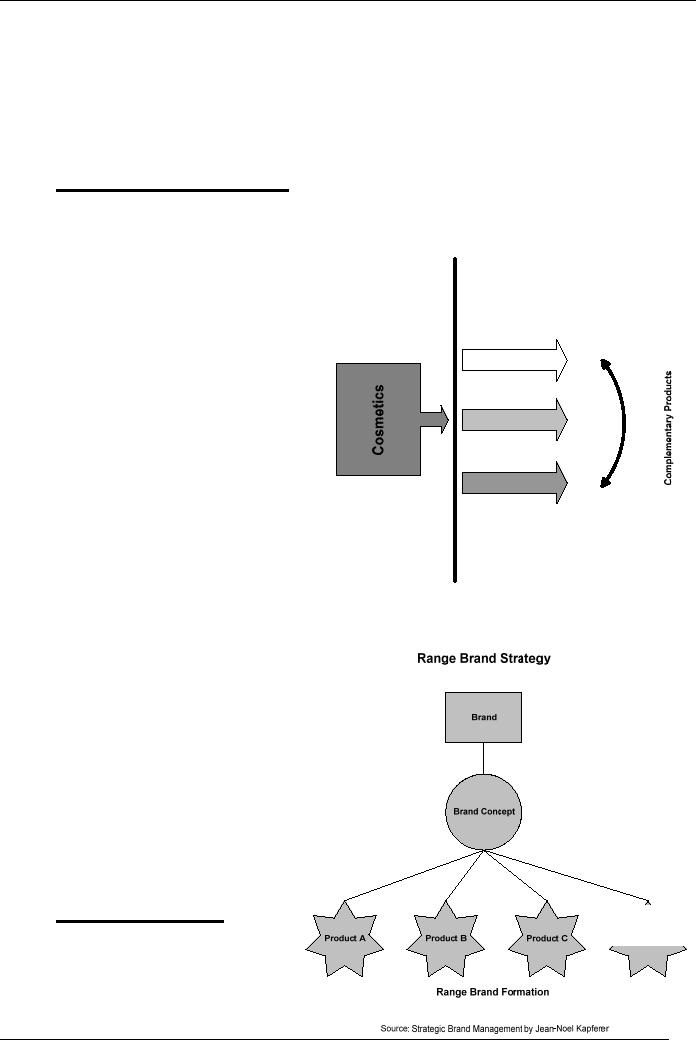 |

Brand
Management (MKT624)
VU
Lesson
27
BRAND
ARCHITECTURE
Introduction
We
have seen that all brands
regardless of what circumstances gave
them birth appear as
independent
brands and play a significant role
through their existence. We
have also seen that
circumstances
can lead to creation of a stand-alone
brand, a line extension, or a
diversification.
Corporate
strategies also lead to a collection of
different brands that are
managed as a portfolio
or
a set of portfolios in case of
large corporations.
What
can be concluded from our discussions so
far is that brands belonging to one
business do
not
work in isolation of each
other for the reason
that one set of circumstances
give rise to the
existence
of another brand whether
extension or stand-alone under a
different name.
Such
developments are not without
links and hence drawing a hard and
fast line between and
among
the boundaries of various brands is
difficult. Their relationships go
across each other's
boundaries
and make those brands appear in hybrid
forms, at times. If a brand is an
extension,
it
could well be part of a
portfolio of a few other brands
that may be a mixed bag of
stand-
alones
and extensions of some mother
brand. The stand-alone(s)
could be an acquired
brand
making
a good combination with other
stand-alones or extensions introduced by
the company
at
different occasions for
different segments. How do you
manage such apparent
complexity?
The
lecture attempts to answer
that.
Brand
architecture
To
understand brand architecture, we
must know that there is a
close relationship between
brands
and products; brands distinguish one
product from the other and
they also indicate
products'
origin. Given that, there
has to be a system followed by
different companies to name
and
then organize their products
as brands in production and marketing
terms. The system
must
also
make it easy for the
customers to understand those products in
terms of buying
different
brands.
Such a system is driven by
the branding policies a
company follows and is known
as
brand
architecture.
Branding
strategies
This
system of naming brands and organizing
them in marketing terms can be
understood by
looking
into how different companies
develop brand-product relationship by
offering every
brand
a separate role. A study has
revealed six different
strategies followed by companies1.
All
the
strategies facilitate branding
distinctions or serve as indicators of
products' origin.
1.
The product brand strategy
PBS
It
involves one particular name assigned to
one particular product. This name
reflects
just
one positioning and hence is restricted to
that positioning. In other
words, for each
new
positioning there is a new
brand name and hence different names
correspond to
different
positions.
104

Brand
Management (MKT624)
VU
Figure
32
P&G
has adopted this as
The
Product-Brand Strategy
brand
management
philosophy.
In almost all
fields
they are a part
of,
they
have different brands
Brand
A
Brand
B
Brand
C
for
different positions
detergents
and soaps. Each
of
the products has
a
precise
and
exclusive
position
to itself.
As
an example, one soap
Product
A
Product
B
Product
C
could
be for skin enhancing
properties,
another for
energy,
another for family
use,
and yet another as a
medicated
one.
As
another example,
a
Positioning
A
Positioning
B
Positioning
C
detergent
could
be
positioned
as the best for
taking
the stains out, the
Source:
Strategic Brand Management by
Jean-Noel Kapferer
other
for overall neatness,
and
yet another as the best
value for money etc. Each
brand has an identity of its
own
and
hence a complete chain of application of
all marketing practices.
The
accompanying
figure graphically explains
the concept.
The
benefits are:
�
Resourceful
companies opt for this
strategy; they like to
create that
multiplication-
of-supplier-effect
to energize the category
with multiple brand entries.
It is the
collective
effort on part of all
players to do their bit in
talking about points
of
difference,
educate the customer and as an
aggregate effect bring the
category to full
bloom,
you will recall from
discussion on multi brands.
�
One
big manufacturer like (P&G)
likes to occupy and dominate
all the functional
segments
of the category, and by meeting
different needs it consolidates its
market
share.
�
Different
products help customers
identify those differences better
than extensions
that
have external similarities. It is
because of these factors
that one starts
appreciating
how the differences among
various offerings of detergents
are
optimized
through their precise
positioning that define
stain removing
properties,
a
neat wash, or something that's
ideal for hand wash
etc.
�
The
product brand strategy is good
for companies that enter a segment to
preempt a
position
and then acquire the role of
the market leader. The name
of the company
may
not be highlighted with the
result that each brand is
independent of each
other
and
the failure of one does not
really affect the
other.
Drawbacks
of the product brand strategy
�
Each
brand launch is a new
launch. It is expensive considering
the costs of
communication
in different sectors of company's
choice.
�
Retailers
are skeptical of new
product's chances of success and hence
resist
stocking.
105

Brand
Management (MKT624)
VU
�
Multiplication
of product brands in narrowly defined
segments demands
quick
return
on investment. It is possible only in new
and emerging markets in
which
even
smaller volumes can bring
about high returns due to
premium pricing.
�
Unlike
extensions, a new brand
cannot benefit from the
success of another one
within
the portfolio.
�
Distributors
give the brand hardly
any patronage despite company
having a high
level
of awareness and reputation.
2.
The line brand strategy
LBS
This
strategy deals basically
with
extensions.
Meaningful success of a
Line
Brand Strategy
brand
can motivate a company
into
extending
the line. The
advantages
are
known to you. This sets
the
stage
for finding meaningful
"fits"
Figure
33
and
"complimentary" products.
The
objective
is to offer
coherent
Lipstick
products
under the same
brand
name.
Upon
success of a brand of
lipstick,
Mascara
the
manufacturer should get
into
complementing
products that may
have
an emotional appeal across
the
Cleansing
Cream
same
clientele. It, in other
words,
exploits
the success of the
concept
by
extending the brand
while
staying
very close to the
central
theme.
The
benefits are:
�
The
eventual extension involves
only marginal costs linked
to distribution and
packaging
etc.
�
It
reinforces the
selling
power
of the brand and
the
image.
�
It
leads to ease
of
distribution.
�
It
reduces launch costs.
The
drawback is:
�
That
you have to stay
very
close to the existing
product.
3.
Range brand strategy
Figure
34
This
strategy offers one
brand
name
through a single
promise
for
a range of products
belonging
to the same area of
competence.
Range brands are
106

Brand
Management (MKT624)
VU
common
among food items soups,
sauces etc., and luggage
industry; suitcases,
brief
cases,
and attaches.
Communication
takes place in one name for promotion to
all the product
subjects.
Brand,
in other words, communicates in a
generic manner by developing a
unique
concept.
4.
The umbrella brand
strategy
When
the same brand supports
several products in different
markets, it is known as
the
umbrella
brand.
Umbrella
Brand Strategy
Yamaha
in bikes, pianos, and
guitars;
Philips in electrical
Figure
35
Umbrella
bulbs
and lighting, electric
Brand
shavers,
and
televisions;
Mitsubishi
in banks, ship
building,
cars, and foods etc
are
all examples of
umbrellas.
The
main benefits
are:
Concept
A
Concept
B
Concept
C
Concept
D
�
One
can capitalize on
the
strength of one
product
and gain the
benefit
of
scale
Product
A
Product
B
Product
C
Product
D
economies
in other
markets.
�
The
almost
instantaneous
goodwill
can
be generated only if
Specific
Specific
Specific
Specific
communications
communications
communications
communications
the
brand is well known
by
product
by
product
by
product
by
product
and
enjoys
great
Market
A
Market
B
Market
C
Market
D
reputation
like the
brands
mentioned above.
�
Firms
of great reputation can save a lot of
money on communications if
they
enter
markets where they were
not present before.
�
In
present day's over-communicated era,
this is a tremendous advantage
given
the
fact that the cost of
achieving awareness is out of reach of so
many
companies.
�
Umbrella
brand strategy allows the
core brand to gain strength
from the
associations
in the areas it was not present
before. Umbrella attracts
new entries
for
the image capital, but in
the process gets more
strength from the new
entries
and
reinforces the image
capital
The
drawbacks are:
�
The
main constraint toward
creating the umbrella is the
fact that each
division
has
to come up against a specialist brand in
its segment convincing
the
customers
that they not only
match, but excel in quality.
In most of the cases,
it
is
not evident except the
Japanese companies! Toshiba in
different segments!
From
computers to TVs to musical
instruments to kitchen appliances and
more
areas
are rightly perceived as
Toshiba's strength.
107

Brand
Management (MKT624)
VU
�
They
have to prove the relevance
of each product they produce
(Toshiba's
example)
otherwise it becomes difficult to
become a dominant force. It
is
because
of this quality factor that
only companies with good reputation can
be
successful
in creating such a strategy.
Mere awareness doesn't
work.
Since
umbrella strategy is a stretch
into categories not charted
and navigated before,
there
should be a limit to the
temptation. It is like stretching a
rubber band; beyond a
certain
point it breaks. It is called the
rubber effect2.
The more categories a
brand
covers,
the more it weakens like a
rubber and hence loses its
force.
Bibliography:
1.
Jean-Noel Kapferer: "Strategic Brand
Management Creating and Sustaining
Brand
Equity
Long Term"; Kogan Page
(188)
2.
Jean-Noel Kapferer: "Strategic Brand
Management Creating and Sustaining
Brand
Equity
Long Term"; Kogan Page
(199)
Suggested
readings:
1.
Jean-Noel Kapferer: "Strategic Brand
Management Creating and Sustaining
Brand
Equity
Long Term"; Kogan Page
(187-210)
108
Table of Contents:
- UNDERSTANDING BRANDS – INTRODUCTION:Functions of Brand Management, Sales forecast, Brand plan
- INTRODUCTION:Brand Value and Power, Generate Profits and Build Brand Equity
- BRAND MANIFESTATIONS/ FUNDAMENTALS:Brand identity, Communication, Differentiation
- BRAND MANIFESTATIONS/ FUNDAMENTALS:Layers/levels of brands, Commitment of top management
- BRAND CHALLENGES:Consumer Revolt, Media Cost and Fragmentation, Vision
- STRATEGIC BRAND MANAGEMENT:Setting Objectives, Crafting a Strategy, The Brand Mission
- BRAND VISION:Consensus among management, Vision Statement of a Fast Food Company, Glossary of terms
- BUILDING BRAND VISION:Seek senior management’s input, Determine the financial contribution gap
- BUILDING BRAND VISION:Collect industry data and create a brand vision starter, BRAND PICTURE,
- BRAND PICTURE:Brand Value Pyramid, Importance of being at pinnacle, From pinnacle to bottom
- BRAND PERSONA:Need-based segmentation research, Personality traits through research
- BRAND CONTRACT:The need to stay contemporary, Summary
- BRAND CONTRACT:How to create a brand contract?, Brand contract principles, Understand customers’ perspective
- BRAND CONTRACT:Translate into standards, Fulfill Good Promises, Uncover Bad Promises
- BRAND BASED CUSTOMER MODEL:Identify your competitors, Compare your brand with competition
- BRAND BASED CUSTOMER MODEL:POSITIONING, Product era, Image Era, An important factor
- POSITIONING:Strong Positioning, Understanding of components through an example
- POSITIONING:Clarity about target market, Clarity about point of difference
- POSITIONING – GUIDING PRINCIPLES:Uniqueness, Credibility, Fit
- POSITIONING – GUIDING PRINCIPLES:Communicating the actual positioning, Evaluation criteria, Coining the message
- BRAND EXTENSION:Leveraging, Leveraging, Line Extension in detail, Positive side of line extension
- LINE EXTENSION:Reaction to negative side of extensions, Immediate actions for better managing line extensions
- BRAND EXTENSION/ DIVERSIFICATION:Why extend/diversify the brand,
- POSITIONING – THE BASE OF EXTENSION:Extending your target market, Consistency with brand vision
- DEVELOPING THE MODEL OF BRAND EXTENSION:Limitations, Multi-brand portfolio, The question of portfolio size
- BRAND PORTFOLIO:Segment variance, Constraints, Developing the model – multi-brand portfolio
- BRAND ARCHITECTURE:Branding strategies, Drawbacks of the product brand strategy, The umbrella brand strategy
- BRAND ARCHITECTURE:Source brand strategy, Endorsing brand strategy, What strategy to choose?
- CHANNELS OF DISTRIBUTION:Components of channel performance, Value thru product benefits
- CREATING VALUE:Value thru cost-efficiency, Members’ relationship with brand, Power defined
- CO BRANDING:Bundling, Forms of communications, Advertising and Promotions
- CUSTOMER RESPONSE HIERARCHY:Brand-based strategy, Methods of appropriations
- ADVERTISING:Developing advertising, Major responsibilities
- ADVERTISING:Message Frequency and Customer Awareness, Message Reinforcement
- SALES PROMOTIONS:Involvement of sales staff, Effects of promotions, Duration should be short
- OTHER COMMUNICATION TOOLS:Public relations, Event marketing, Foundations of one-to-one relationship
- PRICING:Strong umbrella lets you charge premium, Factors that drive loyalty
- PRICING:Market-based pricing, Cost-based pricing
- RETURN ON BRAND INVESTMENT – ROBI:Brand dynamics, On the relevance dimension
- BRAND DYNAMICS:On the dimension of knowledge, The importance of measures
- BRAND – BASED ORGANIZATION:Benefits, Not just marketing but whole culture, Tools to effective communication
- SERVICE BRANDS:The difference, Hard side of service selling, Solutions
- BRAND PLANNING:Corporate strategy and brands, Brand chartering, Brand planning process
- BRAND PLANNING PROCESS:Driver for change (continued), Brand analysis
- BRAND PLAN:Objectives, Need, Source of volume, Media strategy, Management strategy